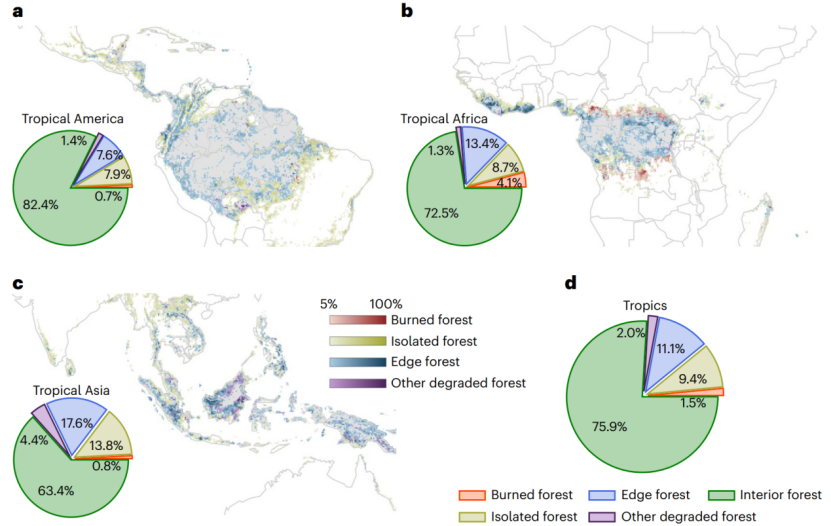Forests make up most of the global land carbon sink and impact the surface energy budget. Forest degradation results in carbon emissions and causes biophysical warming (biogeochemical effects). Meanwhile, forest degradation can directly change the surface biophysical properties (for example, albedo, transpiration and roughness), thus affecting local energy balance and causing temperature change (biophysical effects). Tropics are hot spots of deforestation and degradation in the world. Present studies have demonstrated that the area and the carbon loss due to degradation could be larger than the losses from deforestation in the Amazon region. But the superposition of biophysical and biogeochemical effects of tropical forest degradation is still unclear, while the biophysical effects of forest degradation in the future climate change mitigation policy are often neglected.
Tropical forests have undergone extensive deforestation and degradation during the past few decades, but the area and the carbon loss due to degradation could be larger than the losses from deforestation. Degraded forests also induce biophysical feedback on climate, as they sustain less cooling from evapotranspiration. Here we estimate the biophysical and biogeochemical temperature changes caused by tropical moist forest degradation using high-resolution remote sensing data from 2010.
Associate Professor Li Wei’s Research Group of the Department of Earth Science System (DESS) of Tsinghua University has, in conjunction with several domestic and overseas research institutions, conducted research in tropical moist forests on the above problems by using high resolution satellite observation data. The research first identifies four types of degraded tropical moist forests: burned, isolated, edge and other degraded forests, and analyzed the biophysical and biogeochemical effects of tropical moist forest degradation and quantified the biophysical and biogeochemical effects of tropical moist forest degradation caused by anthropogenic disturbances from 1990 to 2010. It is found in the research that degradation occurred in 24.1% of the total tropical moist forest area in 2010. The land surface temperature of degraded tropical moist forests is higher than that of nearby intact forests 0.78 ± 0.88 °C, leading to a warming effect of 0.022 ± 0.014 °C over the tropics. The cumulative carbon deficit of degraded forests reaches 6.1 ± 2.0 PgC, equivalent to a biogeochemical warming effect of 0.026 ± 0.013 °C. Forest degradation caused by anthropogenic disturbances from 1990 to 2010 induces a daytime warming effect of 0.018 ± 0.008 °C and a carbon deficit of 2.3 ± 0.8 PgC. These values are of the same order of magnitude as those due to deforestation.

Fig. 1 Distribution of the dominant forest degradation types and the area fractions in TMF in 2010
The above results have been published in Nature Geoscience (March 2, 2023) as an article titled “Comparable biophysical and biogeochemical feedbacks on warming from tropical moist forest degradation”. The results have also been reported with high praise in a research briefing titled “The hidden warming effects of the degradation of moist tropical forests” in Research Briefing of the same period. Zhu Lei, a direct-track doctoral candidate of the DESS, Tsinghua University is the first author of the article, and Associate Professor Li Wei is the corresponding author. Other co-authors include Professor Philippe Ciais and Dr. Xu Yindi of Laboratoire des Sciences du Climat et de l’Environnement (LSCE), Dr. Alessandro Cescatti, Senior Researcher of Joint Research Centre, Ispra, Italy, Dr. Maurizio Santoro and Dr. Oliver Cartus of Gamma Remote Sensing, Switzerland, Dr. Katsumasa Tanaka of National Institute for Environmental Studies (NIES), Japan, He Jiaying and Sun Minxuan, postdoctoral fellows, Zhao Zhe, doctoral candidate and Wang Jingmeng, doctoral graduate of the DESS, Tsinghua University. The research has been supported by the National Key Research and Development Program and Independent Research Program of Tsinghua University. This study was supported by the National Key R&D Program of China and the Tsinghua University Initiative Scientific Research Program.
Full-text link: https://www.nature.com/articles/s41561-023-01137-y
Research briefing link: https://www.nature.com/articles/s41561-023-01139-w
Written by Zhu Lei
Edited by Wang Jiayin
Reviewed by Zhang Qiang